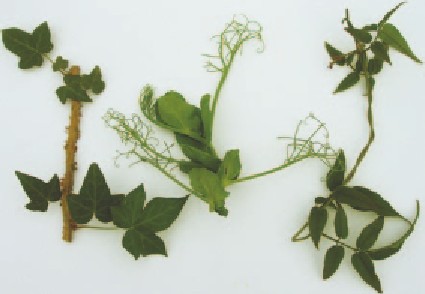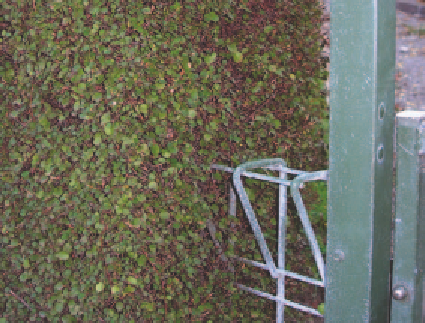Agriculture Reference
In-Depth Information
In order to enjoy the autumn colour of
Virginia creeper/Boston ivy this can be done
after the leaves fall. However, they all benefit
from a late spring trim, or for that matter, any
time they become too heavy or rampant. They
are extremely difficult to kill, but easy to
manage when kept in bounds.
Contrary to popular belief, these 'suction
cups' or aerial roots do not damage walls
(unless they are already crumbling) but when
removed the remains of their adhesive roots/
pads can make the surface unsightly. Damage
by climbers is generally a result of the active
growing stems threading themselves into
small spaces and then expanding as the plant
grows; a maintenance issue.
2
1
3
Figure 4.86
Three adaptations that allow climbers to
ascend. Ivy with aerial roots cling to a solid surface (1).
Tendrils that latch on to any likely support (2), and twiners
that wind their way around a framework (3). Roses and
bougainvillea use hooked thorns to advance.
There are approximately four ways that
climbing plants climb (see Figure 4.86).
Climbers as hedges
Climbers can also be utilised as hedges. Given
a sturdy support such as heavy-gauge wire
fencing, climbers can be trained to the
support and clipped as necessary. Choose
shade-tolerant vines so that the support is
clothed from top to bottom (see Figure 4.87).
Plants such as peas, passionfruit and grapes
climb using tendrils. Tendrils are modified
leaves or stems that reach out to the support,
and coil around it. Many are twiners,
spiralling around their support such as
kiwifruit or jasmine. Roses and bougainvillea
use their hooked thorns to scramble their way
to the top, while ivy, uses aerial roots to cling
to a solid surface.
Self-clinging climbers
Climbers such as
Parthenocissus
spp. (Virginia
creeper),
Ficus pumila
(climbing fig)and
Hedera
spp. (ivy) all have evolved plant parts
that allow them to cling to solid surfaces.
Therefore, they need a wall or solid fence to
climb on; trellis or wire will not support them.
They are vigorous growers that can become
shrubby if left unpruned. As their stems are
attached to their support they are best
hedged hard back to the supporting surface.
Figure 4.87
Wire vine or
Muelenbeckiacomplexa
makes
a dense impenetrable hedge when grown on sturdy wire
fencing.
(Photo taken at Heronswood, Dromana, Victoria)


